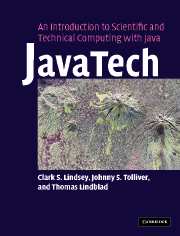Book contents
- Frontmatter
- Contents
- Preface
- Acknowledgements
- Part I Introduction to Java
- Part II Java and the network
- 13 Java networking basics
- 14 A Java web server
- 15 Client/server with sockets
- 16 Distributed computing
- 17 Distributed computing – the client
- 18 Java Remote Method Invocation (RMI)
- 19 CORBA
- 20 Distributed computing – putting it all together
- 21 Introduction to web services and XML
- Part III Out of the sandbox
- Appendix 1 Language elements
- Appendix 2 Operators
- Appendix 3 Java floating-point
- Index
- References
16 - Distributed computing
Published online by Cambridge University Press: 08 January 2010
- Frontmatter
- Contents
- Preface
- Acknowledgements
- Part I Introduction to Java
- Part II Java and the network
- 13 Java networking basics
- 14 A Java web server
- 15 Client/server with sockets
- 16 Distributed computing
- 17 Distributed computing – the client
- 18 Java Remote Method Invocation (RMI)
- 19 CORBA
- 20 Distributed computing – putting it all together
- 21 Introduction to web services and XML
- Part III Out of the sandbox
- Appendix 1 Language elements
- Appendix 2 Operators
- Appendix 3 Java floating-point
- Index
- References
Summary
Introduction
As has been demonstrated, Java is a very capable platform for many scientific computing tasks. Yet Java is still sometimes perceived as slow. While this often is a no-longer-deserved reputation, especially in Java 1.4 and later, there are definitely times when the nature of the scientific calculation is so demanding that typical desktop computing resources are insufficient. In such cases, moving portions of the calculation to a heavy-duty remote server machine, perhaps even a “supercomputer,” makes good sense. In this chapter, we introduce the concept of distributed computing.
We continue with the client/server paradigm discussed in the previous chapters, but rather than simply passing messages via socket connections, the client and server objects directly invoke methods in each other over the network. This allows for much more elaborate and productive interactions. The Java Remote Method Invocation (RMI) or Common Object Request Broker Architecture (CORBA) frameworks take care of the communications, and we do not need to create our own low-level protocols as we did with sockets.
We first discuss just what distributed computing is and what form of distributed computing is of value to scientific calculations. We introduce just a little Unified Modeling Language (UML) as a visual aid to understanding the various components in a distributed application. This use of UML and the Design Pattern approach allows us to describe client/server programs in a more formal manner than in the previous chapters.
- Type
- Chapter
- Information
- Publisher: Cambridge University PressPrint publication year: 2005



